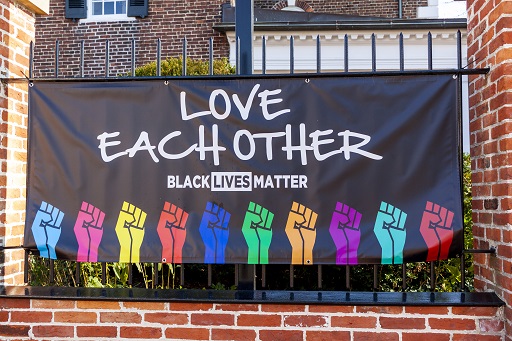2.1 Practising leadership with intersectionality
Leadership practice for racial equity and justice flips the logic of intersectionality on its head – instead of viewing intersectionality as a description of multiple forms of oppression, it looks for opportunities to expand in more inclusive and empowering directions (Gamboa et al., 2021). Intersectionality therefore becomes a positive concept, a way of opening up possibilities.
Intersectional leadership operates along two dimensions. First, it challenges existing perceptions of who is viewed as a legitimate and powerful leader, thereby making room for people with various intersections of identities to be regarded as potentially powerful leaders. Second, the practice of intersectional leadership is about continually increasing our understanding of who is being left behind, and therefore how leadership could be strengthened through being more inclusive.
It was this kind of leadership that informed the creation of Black Lives Matter. One of its founders, Alicia Garza, has spoken about the need for all successful movements to work on always broadening their appeal. For Garza (2021), this is accomplished through deep and critical reflection and learning, through ‘unlearning’ (p. 144) assumptions and prejudices, and then re-learning ‘how and why people have been left behind’ (p. 144). For Garza, this process is not about generating hierarchies of oppression – ‘Oppression Olympics’ (p. 146) – where one group’s suffering is held as somehow worthier of attention than others. Rather, it is about examining:
… how groups that experience double or triple discrimination get their needs met at the same time as, not in spite of, other groups in the same situation. This is important because it, again, exposes how and why we leave some people behind, and it forces us to acknowledge the ways in which we keep ourselves from reaping the opportunity to build movements that model the world we want to live in right now.
This positive way of approaching intersectional leadership makes sense for people committed to equity and justice – the whole premise of our leadership is that people are not left behind. You will now reflect on how a positive and intersectional approach to leadership can be applied to organisations.
Activity 4 Implementing intersectional leadership at work
Watch the following video, in which Lurraine Jones talks about what an intersectional approach to leadership means in a university context, and outlines some general principles.
As you watch, try to identify two key practices Lurraine highlights for intersectional leadership. Could you apply these to your own contexts? What kind of practices would you pursue if this was the case?

Transcript: Video 2 Lurraine Jones - an intersectional approach to leadership in a university context
Discussion
Lurraine highlights two very important issues to consider when practising intersectional leadership:
- Firstly, Black or any other ethnic identity is not a monolith. It is problematic to see Black people or members of another ethnicity as a monolith – there is diversity within any given group. Intersectional leadership implies seeing people as individuals and avoiding the trap of groupism.
- Secondly, diverse thoughts and experiences are needed around the decision-making tables. Intersectional leadership requires expanding the leadership group to give people from different backgrounds the opportunity to contribute to leadership, and secure buy-in from across the spectrum.
Now that you’ve learned about the power of CRT and intersectionality for enriching the notion of leadership as product, this week comes to a close.

